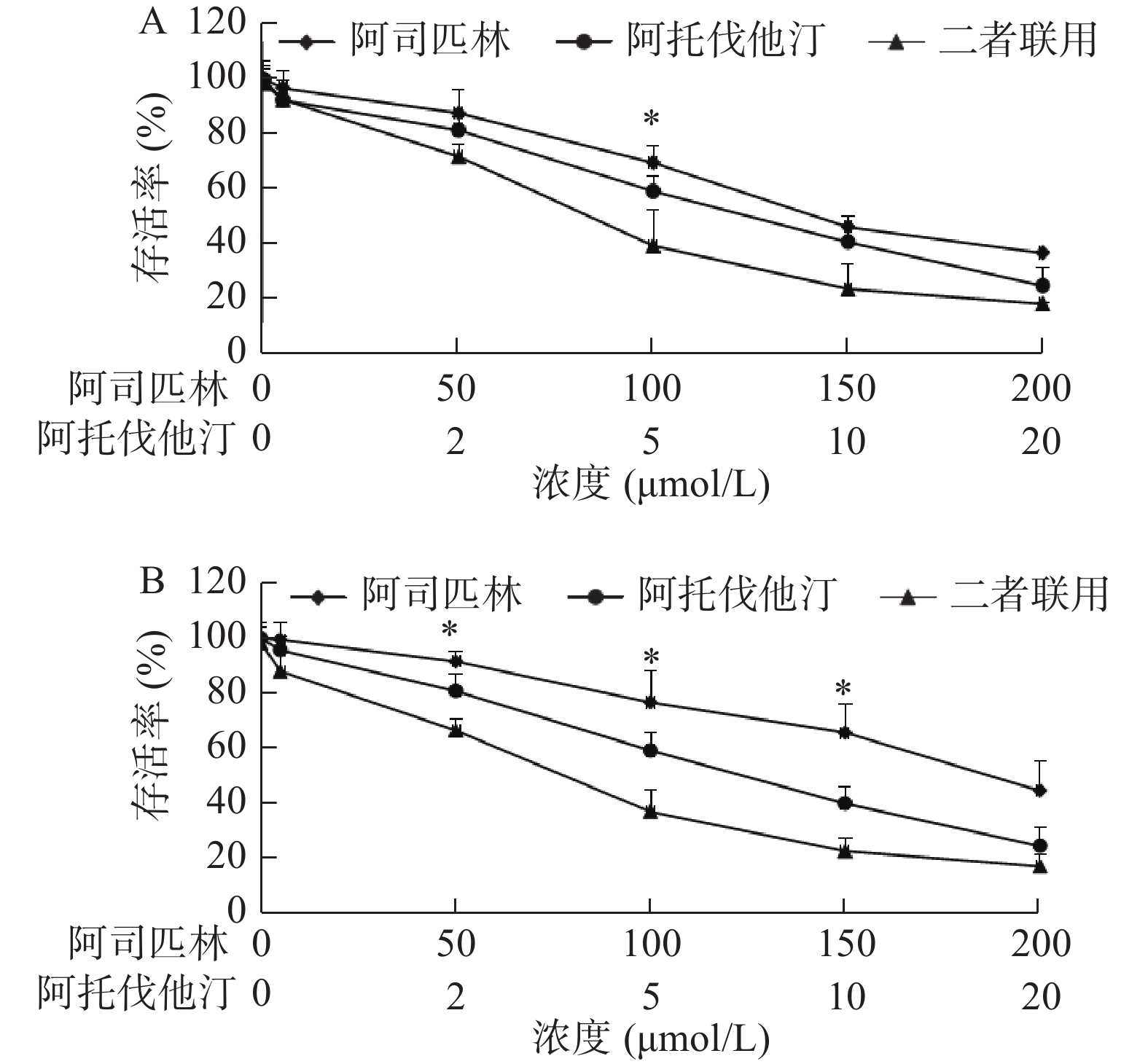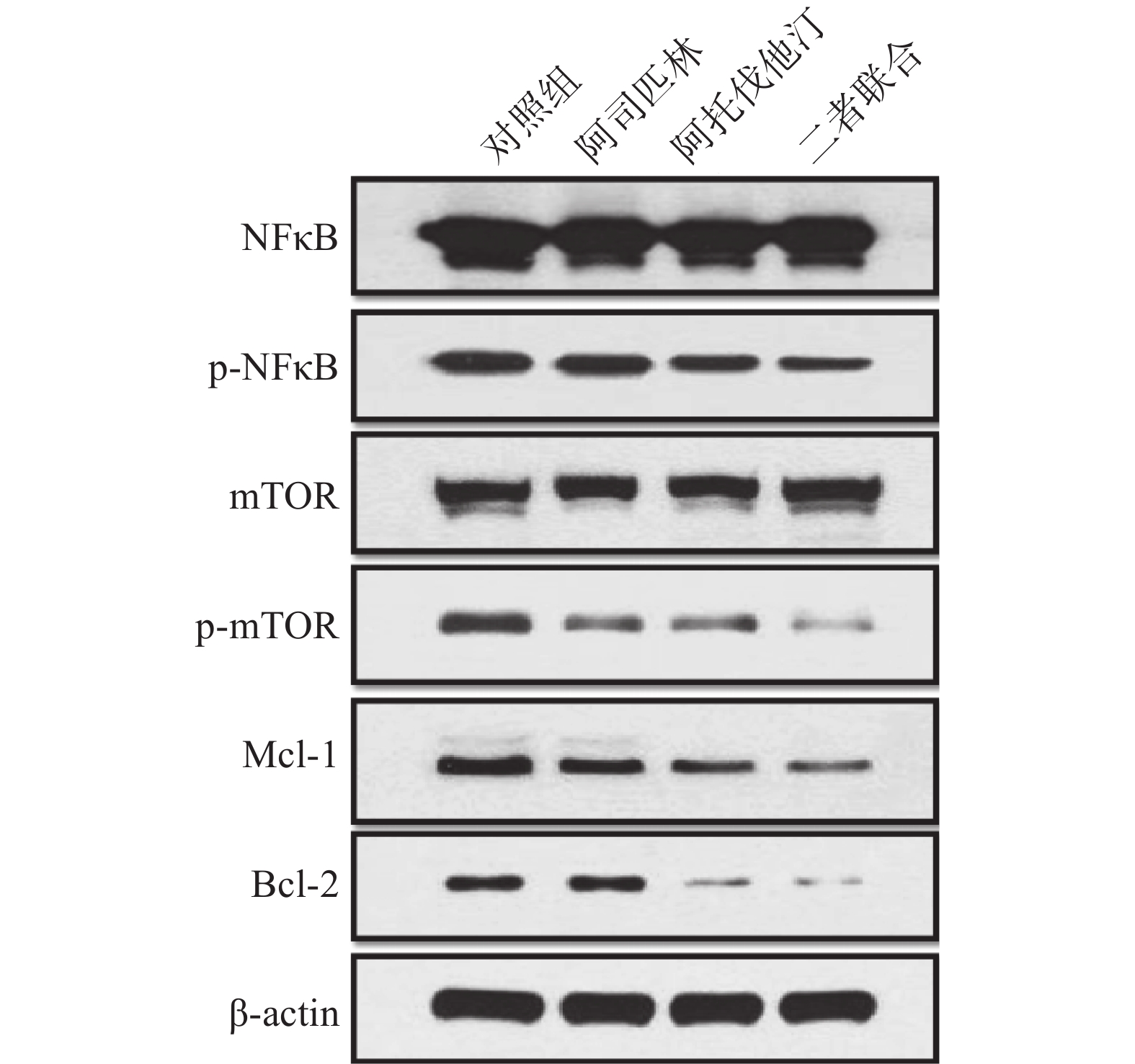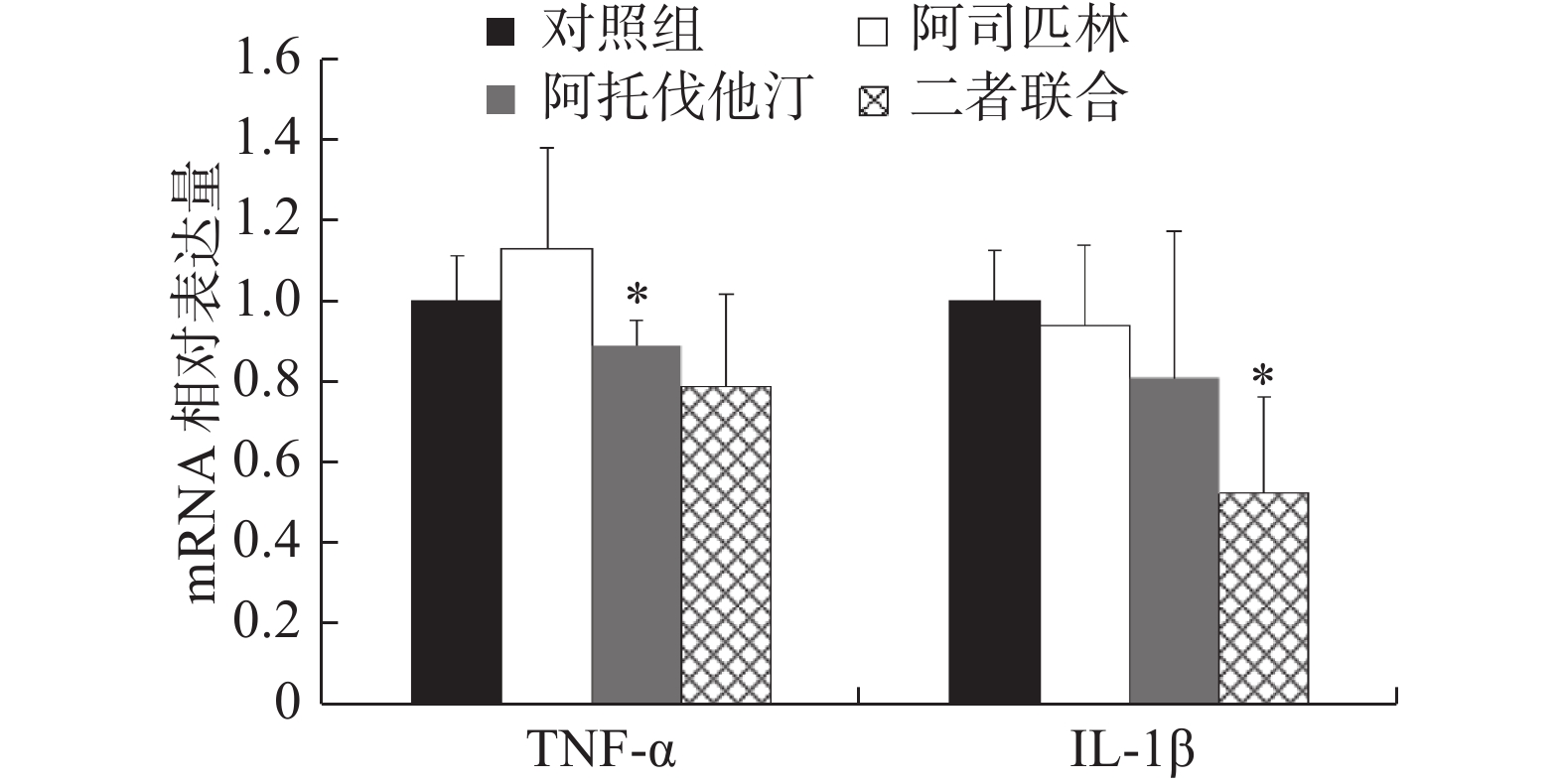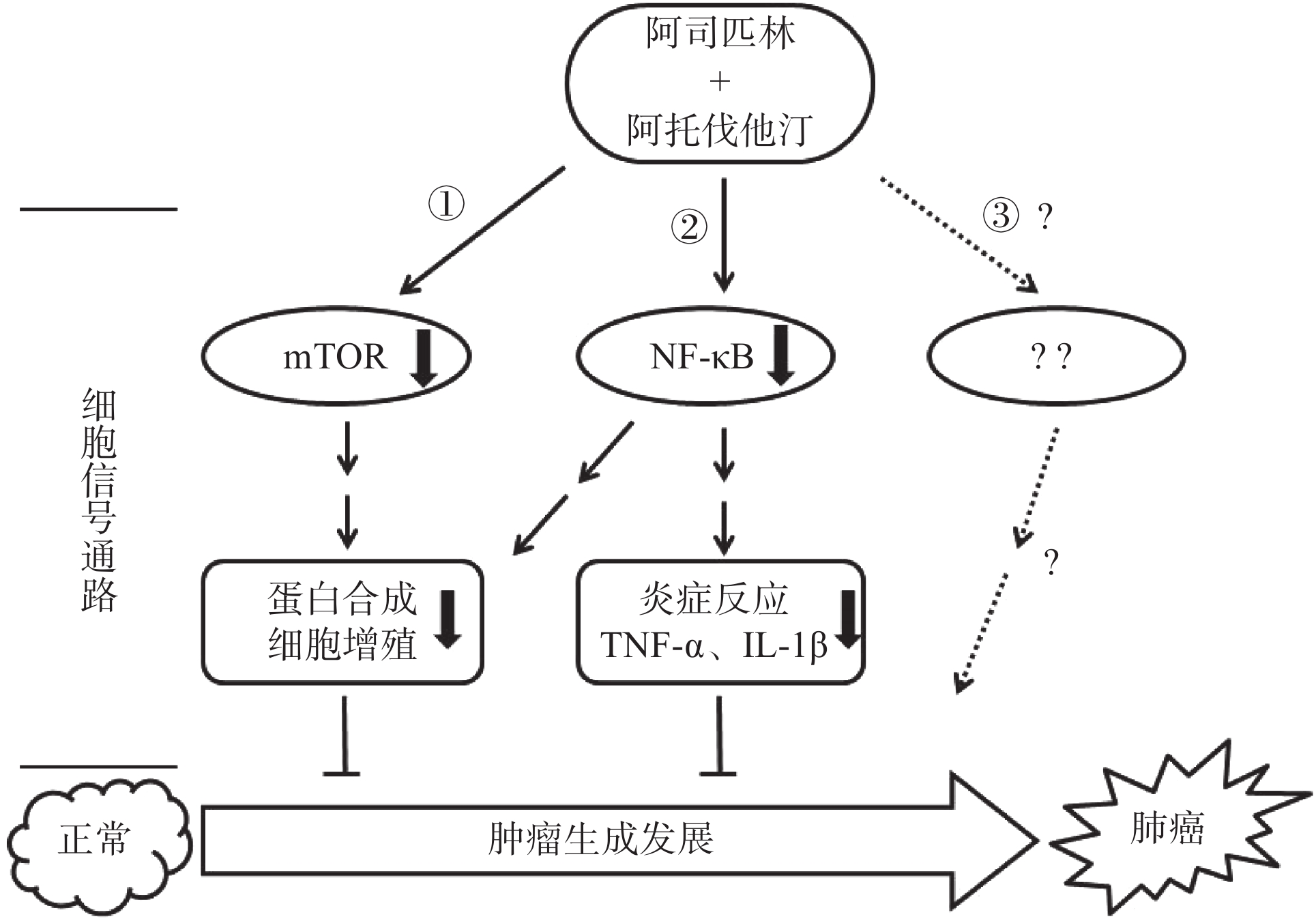-
非小细胞肺癌(non-small cell lung cancer, NSCLC)是肺癌中最常见的组织学类型,发病率逐年增高,无论是在我国还是全球,都已成为致死率最高的癌症之一[1]。因此,对于NSCLC的防治,特别是探索新的化学预防策略显得尤为重要。目前新兴出现的以靶向和免疫疗法为手段治疗NSCLC越来越引人关注,尽管如此,对于肺癌的治疗同样也面临着研发新型抗癌药物的挑战,包括研发过程中所需巨额费用和时间,而重新使用具有潜在癌症治疗的非抗癌药物用于癌症治疗,不仅可以节省研发新药所需的人、财、物力,甚至还可能提高治疗效果。临床前研究和数据证实许多非抗癌药物具有潜在的预防和治疗癌症的作用,譬如对NSCLC的预防和治疗,这些药物就有阿司匹林、他汀类药物等[2]。
阿司匹林和阿托伐他汀是广泛用于心血管疾病的一线防治用药。近年来,它们已经被证实可能成为新兴的、可用于不同类型肿瘤(包括NSCLC)的化学预防药物[3-5]。尽管它们抗NSCLC的确切分子机制尚需要进一步研究,但文献报道其抗肿瘤作用机制存在重叠,即均可靶向作用于mTOR和NFκB通路。据此我们假设:阿司匹林和阿托伐他汀联合使用可通过共同抑制mTOR和NFκB通路而发挥协同抗NSCLC效应。为验证假设,本实验选取了非小细胞肺癌A549和NCI-H460细胞,在体外研究阿司匹林联合阿托伐他汀对它们细胞增殖的影响及其相关作用机制,期望在应用阿司匹林和阿托伐他汀防治心血管疾病的同时可以降低NSCLC的患病风险,以及为设计新型控制NSCLC的干预策略提供理论依据。
-
人非小细胞肺癌A549和NCI-H460细胞(美国Manassas公司),培养于含10%胎牛血清的DMEM培养基(美国Sigma-Aldrich公司),置37 ℃饱和湿度、5% CO2培养箱孵育。阿司匹林和阿托伐他汀标准品化合物(美国Sigma-Aldrich公司),用DMSO溶解后−20 ℃保存。RNA提取试剂盒购自上海博彩生物科技公司,BCA法蛋白定量试剂盒和TNF-α和IL-1β反转录试剂盒购自美国Thermo scientific公司,SYBR qPCR试剂盒购自美国Invitrogen公司。mTOR、p-mTOR、NFκB、p-NFκB、Bcl-2、Mcl-1、β-Actin抗体以及鼠、兔二抗购自美国CellSignal公司。其他试剂以及仪器设备由本实验室提供。
-
分别取对数生长期非小细胞肺癌A549和NCI-H460细胞,用胰酶-EDTA消化并计数,将100 μl的细胞混悬液接种于96孔培养板使每孔的细胞数约为5×103个/100 μl。待24 h后细胞贴壁,加入阿司匹林或/和阿托伐他汀(先用DMSO溶解再用DMEM培养液稀释成不同浓度)。使与细胞作用的阿司匹林浓度分别为0、5、50、100、150、200 μmol/L,阿托伐他汀浓度分别为0、1、2、5、10、20 μmol/L。每个浓度设3个复孔,对照组加入DMEM培养液。置于37 ℃、5% CO2培养箱72 h后,加入10 μl MTS溶液(临用前用PBS溶解,pH7.4,质量浓度为5 g/L),再置培养箱继续培养1 h,于酶标仪490 nm处检测吸光度值(A值)。
细胞增殖存活率(%)=(实验孔A值/对照孔A值)×100。
-
分别将A549和NCI-H460细胞悬液接种于两个6孔培养板中,保证每孔细胞数约为1×105个/孔,次日待细胞贴壁铺满后进行划痕,PBS清洗一遍后更换无血清培养液。根据MTS实验结果选取了浓度为100 μmol/L阿司匹林、5 μmol/L阿托伐他汀以及二者联合作为处理药物,共设3个给药组和1个对照组进行实验,24 h后观察划痕距离变化并在显微镜下拍照,与给药前进行比较。
-
以1×105个/孔接种NCI-H460细胞于6孔板中,同样设置有浓度为100 μmol/L阿司匹林、5 μmol/L阿托伐他汀以及二者联合的3个药物处理组和1个对照组,并给予对应浓度的药物处理细胞,对照组不作处理。继续培养72 h后收集细胞,PBS洗细胞3次,加入细胞裂解液(含20 mmol/L Tris-Hcl/pH 7.5、1% Triton、150 mmol/L NaCl、1 mmol/L EDTA、2.5 mmol/L 无水焦硫酸钠、1 mmol/L β-甘油磷酸盐、1 µg/ml亮肽素和1 mmol/LPMSF),用细胞刮刀将细胞刮下,4 ℃冰浴中超声破碎细胞,待细胞膜破碎反复涡旋后,于4 ℃、12 000 r/min离心,取上清,BCA法蛋白定量后样品经SDS-PAGE分离,蛋白电转至PVDF膜,将PVDF膜在5%牛奶中封闭1 h,加入1∶1 000的一抗,4 ℃孵育过夜,PBS洗涤,加入酶标二抗室温1 h,PVDF膜经ECL化学发光底物检测蛋白。
-
以1×105个/孔接种NCI-H460细胞于6孔板中,设置有浓度为100 μmol/L阿司匹林、5 μmol/L阿托伐他汀以及二者联合的3个药物处理组和1个对照组。次日待细胞贴壁换培养液给予对应浓度的药物处理细胞,对照组不作处理,继续培养72 h后收集细胞。采用RNA提取试剂盒(上海博彩)提取细胞总RNA,按照TNF-α和IL-1β反转录试剂盒说明书(美国Thermo scientific公司)操作进行反转录。得到的cDNA按照SYBR Green PCR Master Mix试剂盒说明书进行实时定量PCR检测。每个PCR反应体系包括:SYBR Green PCR Master Mix 10 μl、cDNA模板2 μl、10 μmol/L上下引物(表1)各0.4 μl以及7.2 μl去离子水,总反应体积为20 μl,经7300 qRT-PCR系统(Applied Biosystems)检测,反应循环参数为95 ℃ 5 s、60 ℃ 35 s共40个循环。基因的表达用ΔΔCt法计算,以β-actin作为内参。
表 1 qRT-PCR引物序列
引物名称 引物序列(5’-3’) TNF-α 上游:ACCCTCACACTCAGATCATTCTTCTC 下游:CAGATTGACCTCAGCGCTGAGTTC IL-1β 上游:CCAGCAGGTTATCATCATCATCC 下游:CTCGCAGCAGCACATCAA β-actin 上游:TCACCCACACTGTGCCCATCTACGA 下游:CATCGGAACCGCTCGTTGCCAATAG -
使用SPSS 16.0软件进行数据处理,所有数据以(
$ \bar{x}\pm s $ )表示,采用t检验进行两组间差异比较,P<0.05为显著差异。 -
我们选取了浓度分别为0、5、50、100、150、200 μmol/L的阿司匹林和0、1、2、5、10、20 μmol/L的阿托伐他汀处理A549和NCI-H460细胞,72 h后采用MTS法测定两种细胞的增殖活性,以浓度为横坐标,细胞存活率为纵坐标绘制曲线(图1)。结果显示:阿司匹林和阿托伐他汀单用(浓度分别≥100和5 μmol/L)或二者联用均能明显抑制A549和NCI-H460细胞增殖,且二者联用抑制作用大于单用。例如,100 μmol/L阿司匹林和5 μmol/L阿托伐他汀,以及二者联用处理A549细胞,72 h后存活率(与对照孔比较)分别为(69.64±5.95)%、(59.31±5.66)%和(39.51±13.22)%,联合与单用比较,差异有统计学意义(P<0.05)。同样相同浓度的阿司匹林和阿托伐他汀以及二者联用处理NCI-H460细胞,72 h后与存活率(与对照孔比较)分别为(76.73±11.30)%、(59.13±6.61)%和(36.82±8.15)%,且联合与单用比较,差异亦有统计学意义(P<0.05)。
-
根据MTS实验结果,选取了浓度为100 μmol/L阿司匹林、5 μmol/L阿托伐他汀以及二者联合作为处理药物,共设3个给药组和1个对照组进行实验,24 h后观察划痕距离变化并在显微镜下拍照(图2)。结果显示:与给药前比较,阿司匹林、阿托伐他汀以及二者联合均较明显抑制了两种细胞的迁移与侵袭,且二者联合的抑制作用显著增强。
-
选取浓度为100 μmol/L阿司匹林、5 μmol/L阿托伐他汀以及二者联合作为处理药物,共设3个给药组和1个对照组处理NCI-H460细胞,72 h后收集细胞。细胞裂解提取蛋白并采用BCA法测定总蛋白,采用Western blotting法检测相关蛋白的表达,结果如图3。
结果显示:100 μmol/L阿司匹林、5 μmol/L阿托伐他汀以及二者联合均可以抑制p-NFκB、p-mTOR以及抗凋亡因子Mcl-1和Bcl-2的蛋白表达,且与单药相比,二者联合抑制效应增强,表明阿司匹林和阿托伐他汀联合可以产生协同抑制作用。但与对照组比较,给药组对总NFκB和总mTOR的蛋白表达均无明显影响。
-
同样,选取浓度为100 μmol/L阿司匹林、5 μmol/L阿托伐他汀以及二者联合作为处理药物,共设3个给药组和1个对照组处理NCI-H460细胞,72 h后收集细胞。提取细胞总RNA,按照试剂盒说明书操作对TNF-α和IL-1β进行实时定量PCR检测,结果如图4。
结果显示:与对照组比较,阿司匹林组、阿托伐他汀组以及二者联合处理组NCI-H460细胞中TNF-α表达量分别是对照组的(1.13±0.25)、(0.89±0.06)和(0.79±0.23)倍,IL-1β表达量分别是对照组的(0.94±0.20)、(0.81±0.36)和(0.52±0.24)倍。其中,阿托伐他汀组TNF-α和联合处理组IL-1β的表达,与对照组比较差异存在统计学意义(P<0.05),尤其是联合处理组IL-1β的表达差异最为明显,与对照组比较下降了近50%。
-
流行病学数据显示,服用阿司匹林或者阿托伐他汀的人群出现了肺癌患病率降低或者肿瘤发生发展的延缓。譬如,Van Dyke等[6]发现成人加强剂量的阿司匹林可以降低55~64岁妇女罹患NSCLC的概率;Jiang等[7]报道,标准剂量阿司匹林(>325 mg)服用5年以上降低了肺癌事件的发生。Lin等[8]在采用倾向评分法对5 118名65岁以上的Ⅳ期NSCLC患者的临床研究发现,服用了阿托伐他汀平均生存时间提高了3个月,并且得出结论阿托伐他汀提高了Ⅳ期NSCLC患者的存活率。这些报道均提示阿司匹林和阿托伐他汀对肺癌具有直接的抑制效应,然而两药联合使用时是否可以表现出协同抗癌活性,目前报道较少,He等[9]研究显示阿司匹林和阿托伐他汀对前列腺癌细胞的增殖有联合抑制作用,但对肺癌细胞的作用未见报道。据此,我们选取了非小细胞肺癌A549和NCI-H460细胞,在体外研究阿司匹林联合阿托伐他汀对它们的抑制效应及其相关作用机制。
首先,我们采用MTS法检测了阿司匹林和阿托伐他汀单用及联合对A549和NCI-H460细胞增殖的影响,结果显示(图1):当阿司匹林和阿托伐他汀的浓度分别大于100和5 μmol/L时均能明显抑制A549和NCI-H460细胞增殖,且二者联用抑制作用明显大于各自单用。他汀类药物在体内外可以抑制癌细胞(包括NSCLC)的增殖已有文献报道[10-12],该结果与之相符。但阿司匹林在体外抑制NSCLC细胞的增殖,以及联合阿托伐他汀发挥协同抑制作用,文献未见报道。所以,本实验结果提示阿司匹林联合阿托伐他汀可以发挥协同抑制NSCLC细胞增殖效应。其次,我们在细胞划痕实验中观察到100 μmol/L阿司匹林和5 μmol/L阿托伐他汀均能抑制A549和NCI-H460细胞的迁移与侵袭,且二者联合抑制作用显著增强(图2),该结果也进一步说明阿司匹林联合阿托伐他汀发挥协同抑制NSCLC细胞效应。
阿司匹林和他汀类药物在临床上广泛应用于预防和治疗心血管疾病,但近年来由于其抗炎作用、抗肿瘤活性的研究发现,且其分子机制研究已经比较成熟,已经无可争议的成为癌症预防的候选药物。通过文献综述我们发现,阿司匹林和他汀类药物发挥抗肿瘤的分子机制有重叠,即均可以直接或间接作用于mTOR和NFκB信号靶点[4,13],影响它们通路下游一些基因和蛋白的表达,进而发挥抑制癌细胞增殖、诱导凋亡、抗血管生成以及转移等一系列抗肿瘤活性。本研究我们在NCI-H460细胞中验证了阿司匹林和阿托伐他汀靶向作用于mTOR和NFκB信号靶点,抑制它们的磷酸化过程(即抑制活化),且能够抑制它们信号转导下游抗凋亡基因Mcl-1和Bcl-2的蛋白表达。同时还发现当阿司匹林和阿托伐他汀联合应用时,对这些信号通路中这些蛋白的表达下调作用更加明显,提示二者联合发挥了协同作用(图3)。另外,文献报道他汀类药物可以通过作用炎症调控因子NFκB影响细胞内一些重要炎症因子(如TNF-α、IL-8等)的生成[14-15],同样,我们在研究中也发现阿托伐他汀降低了NCI-H460细胞中炎症因子TNF-α的mRNA表达,对IL-1β的mRNA表达也有抑制作用但差异没有统计学意义(与对照组比较P>0.05,图4),阿司匹林未发现有相同的作用,但二者联合显著降低了IL-1β的mRNA水平,与对照组比较下降近50%。此结果提示阿司匹林和阿托伐他汀联合应用可能对某些促炎因子(如IL-1β)的影响有协同作用。
综上所述,阿司匹林联合阿托伐他汀可以协同抑制非小细胞肺癌A549和NCI-H460细胞的增殖,其机制为共同作用于mTOR和NFκB信号靶点并且影响该靶点信号转导下游调控基因的表达,如抗凋亡基因Mcl-1、Bcl-2以及炎症因子TNF-α和IL-1β(图5),但这种协同作用是如何通过作用mTOR和NFκB并调控其下游目的基因来实现的,以及是否还通过作用于新的信号靶点或者其他信号通路(图5路线③)发挥协同抑制作用有待于进一步研究求证。
Study on the synergistic effects of aspirin and atorvastatin on cell proliferation of non-small cell lung cancer cells
-
摘要:
目的 研究阿司匹林联合阿托伐他汀对非小细胞肺癌细胞A549和NCI-H460细胞增殖的影响及其作用机制。 方法 采用MTS法检测阿司匹林、阿托伐他汀以及二者联合对A549和NCI-H460细胞抗增殖活性,细胞划痕实验检测A549和NCI-H460细胞的迁移和侵袭活性,Western blotting法检测NCI-H460细胞中mTOR和NFκB信号通路相关蛋白的表达,采用实时定量PCR检测NCI-H460细胞中炎症因子TNF-α和IL-1β mRNA的表达。 结果 阿司匹林、阿托伐他汀单用(浓度分别≥100、5 μmol/L)以及二者联用均能明显抑制A549和NCI-H460细胞增殖和侵袭,且二者联用抑制作用大于单用。阿司匹林、阿托伐他汀以及二者联合均可以抑制NCI-H460细胞中p-NFκB、p-mTOR以及抗凋亡因子Mcl-1和Bcl-2的蛋白表达,且与单药相比,二者联合抑制作用增强。阿托伐他汀可以降低NCI-H460细胞TNF-α mRNA的表达,联合阿司匹林可以显著降低IL-1β mRNA的表达(与对照组比较下降了近50%,P<0.05)。 结论 阿司匹林联合阿托伐他汀可以协同抑制非小细胞肺癌细胞A549和NCI-H460的细胞增殖,其作用机制是协同抑制了mTOR和NFκB信号通路。 -
关键词:
- 阿司匹林 /
- 阿托伐他汀 /
- 协同作用 /
- 非小细胞肺癌 /
- mTOR和NFκB信号通路
Abstract:Objective To study the synergistic effects of aspirin and atorvastatin on cell proliferation of non-small cell lung cancer cell A549 and NCI-H460 and the mechanism of these actions. Methods The proliferation of A549 and NCI-H460 cells treated by aspirin or/and atorvastatin were determined by MTS assay. The migration of A549 and NCI-H460 cells were conducted by wound-healing assay. The expression of relevant protein in mTOR and NFκB signaling pathway were detected by western blotting. The mRNA expression of TNF-α and IL-1β were detected by quantitative real-time PCR. Results Aspirin or/and atorvastatin inhibited the proliferation and migration of A549 and NCI-H460 at concentration of 100 and 5 μmol/L or greater. The effect was enhanced by the combination of aspirin and atorvastatin. Aspirin or/and atorvastatin inhibited the protein expression of the phosphorylation of mTOR and NFκB, and down-regulated anti-apoptotic regulators Bcl-2 and Mcl-1 in NCI-H460 cells. The combination treatment of aspirin and atorvastatin was more efficacious than the single treatment. Atorvastatin decreased the mRNA expression of TNF-α. The combination of atorvastatin with aspirin decreased the mRNA expression of IL-1β by nearly 50 percent compared to the control (P<0.05). Conclusion Aspirin and atorvastatin have synergistic inhibitory effects on cell growth of non-small cell lung cancer cell A549 and NCI-H460 by suppressing mTOR and NFκB signaling pathway. -
氯吡格雷是一种前药,其代谢产物是血小板聚集抑制剂,可以选择性地抑制二磷酸腺苷(ADP)与其血小板P2Y12受体的结合及继发的ADP介导的糖蛋白GPⅡb/Ⅲa复合物的活化。它是经皮冠状动脉介入治疗(PCI)术后治疗方案中的主要药物,可以改善疾病的预后,预防支架内再狭窄[1]。但氯吡格雷作为前药,需要经肝药酶代谢为活性产物才能发挥药效。此外,还有其他因素会影响氯吡格雷的血药浓度和临床疗效,包括基因多态性,生理状况,肝肾功能、合用药物以及年龄等[2]。研究表明,主要是编码CYP2C19酶的等位基因突变会导致氯吡格雷代谢减慢,使其对血小板的抑制作用减弱。已有报道认为在亚裔人群中,能导致P450酶活性下降或者丢失的等位基因有两个位点,一个是CYP2C19*2,另一个是CYP2C19*3,这两个等位基因的突变都会导致氯吡格雷疗效减弱[3-5]。
由于氯吡格雷的疗效和不良反应存在个体差异,不同患者的剂量需求不一样[6-7]。本研究通过实验对PCI术后患者的代谢酶基因型和体内血药浓度进行测定,探索基因多态性对血药浓度、血小板抑制率和安全性的影响,来指导临床实施个体化治疗,为PCI术后患者的合理治疗提供依据。
1. 材料与方法
1.1 仪器与试剂
LC-20AB高效液相色谱系统(检测器为SPD-M20A,日本岛津);TG1650-WS高速离心机(上海卢湘仪);乙腈(色谱纯,德国Merck);甲酸(分析纯,中国国药集团)。荧光检测仪(西安天龙科技有限公司);PHARM-GENE 01 SNP分析保存液;PHARM-GENE 200 SNP分析样本处理试剂;NH4Cl预处理液。氯吡格雷片(波立维,75mg,赛诺菲制药,批准文号:J20180029),阿司匹林肠溶片(拜阿司匹林,100mg,批准文号:H20130339)。
1.2 研究对象
纳入2017年6月至2019年12月心内科87 例PCI 术后服用氯吡格雷联合阿司匹林抗血小板治疗的患者(氯吡格雷75mg,1次/d;阿司匹林100 mg,1次/d)。
纳入标准如下:①接受氯吡格雷联合阿司匹林双抗治疗的患者,年龄<80岁;②氯吡格雷用药时间应大于5 d,以保证体内药物处于稳态。
排除标准如下:①使用了对药物代谢酶活性有影响的药物,包括细胞色素P450 的诱导剂(如苯巴比妥、水合氯醛、苯妥英钠、利福平等)和活性抑制剂(如氯霉素、对氨基水杨酸、异烟肼、保泰松等);②治疗前或治疗中发生了肝或肾功能改变;③同一份样品,经多次测量,其血药浓度变异系数(CV)>25%。本研究经医院伦理委员会批准(批号:2017-KL002-03)。
1.3 血样采集与检测
1.3.1 血样采集
药物在体内经4~5个给药周期可以达到稳态,所以于氯吡格雷开始服药后第6天,在给药前静脉采血。
1.3.2 氯吡格雷血药浓度监测
使用RP-HPLC法检测人血浆中氯吡格雷的药物浓度,血清样品300 μl置于1.5 ml离心管中,加内标溶液900 μl,涡旋振荡30 s,以15000 r/min转速,离心3 min,取上清液10 μl,经0.45 μm滤膜过滤后进样分析[8]。
1.3.3 CYP2C19基因型的检测
使用非扩增免疫杂交技术检测CYP2C19的基因型,操作步骤:①使用耀金保预处理标本,收集DNA;②耀金分带有针对特定SNP位点的荧光染色原位杂交探针,使用耀金分对标本DNA进行原位杂交检测;③标本DNA中含有特定碱基时可以检测到荧光信号,判断目标碱基类型[9]。
1.4 血小板抑制率的评估
血栓弹力图是一种检测方式,便于快速、准确地对血小板的活性以及抗血小板聚集的效果进行评价和分析。记录的参数包括:凝血反应时间(R)、凝血形成时间(K)、凝固角(α)、最大血凝块强度(MA)和综合凝血指数。
1.5 安全性评估
氯吡格雷最主要的不良反应包括呼吸困难以及出血。根据国际多中心、随机对照试验(PLATO)[10],按照呼吸困难的程度划分:轻度,易于察觉到的轻微呼吸困难症状,但可以耐受,不影响正常体力活动;中度,呼吸困难影响了正常的体力活动,但可以耐受;重度,呼吸困难导致无法完成正常的体力活动。根据PLATO研究[10]将出血事件分为:主要出血和次要出血。
1.6 统计分析
样本的基因频率经Hardy-Weinberg遗传平衡检验,检验结果P>0.05,表明收集的样本符合H-W平衡,具有群体代表性。所有数据采用SPSS20.0进行统计分析。率的比较选择双侧χ2检验,各组之间的血药浓度比较采用方差分析或t检验,P<0.05为差异有统计学意义。
2. 结果
2.1 样本基本特征
本研究中共纳入87名患者,均检测了CYP2C19的基因型和氯吡格雷的血药浓度测定。其中男性46名,女性41名,患者平均年龄为(66.2±7.9)岁,平均体重(55.3±12.3)kg。患者基本情况及检测结果见表1。对样本CYP2C19的基因频率进行了Hardy-Weinberg遗传平衡检验,计算结果Chi-square为1.12,P>0.5,结果见表2。结果表明,收集的样本符合H-W平衡,具有群体代表性。
表 1 患者的基本特征(n=87)项目 信息 值 人口学特征 性别(男/女) 46/41 年龄(n±s) 66.2±7.9 体重(n±s) 55.3±12.3 基因型 快(例) 34 中(例) 38 慢(例) 15 血栓弹力图参数 R(min) 5.72±1.51 K(min) 1.52±0.33 α角(deg) 70.44±7.02 MA(mm) 65.58±5.93 综合凝血指数 1.01±1.33 血小板抑制率(%) 62.56±31.22 不良反应 呼吸抑制(%) 10.34%(9/87) 出血(%) 5.75%(5/87) 表 2 CYP2C19基因型分布频率(n=87)基因表型 基因型 基因频率/% Chi-square H-W平衡检验/P 快 CYP2C19*1/*1 43.59(34/87) 1.12 >0.5 中 CYP2C19*1/*2 48.71(38/87) CYP2C19*1/*3 慢 CYP2C19*2/*2 7.69(15/87) CYP2C19*3/*3 2.2 氯吡格雷治疗后的血小板抑制率和安全性
87例患者接受氯吡格雷治疗后,血药浓度分布于2~7 mg/L之间,血小板抑制率分布于20%~90%之间。常见的不良反应是呼吸抑制[10.34%(9/87)]和出血[5.75%(5/87)]。
2.3 基因多态性对血药浓度、血小板抑制率和安全性的影响
在本研究中,根据CYP2C19的基因型进行了分类(快、中、慢)。快、中和慢代谢型患者的平均血药浓度分别为2.64±1.03、2.88±1.79和5.23±3.23 mg/L,使用t检验分析两两之间的血药浓度,结果显示,血药浓度在快、中代谢型之间没有显著性差异(P=0.667),但慢代谢型中的血药浓度在与快、中代谢型比较时有统计学差异(P<0.05)。快、中、慢代谢型的血小板抑制率分别是(66.26±24.71)%、(67.77±22.32)%和(42.45±17.88)%,采用方差分析进行统计,显示基因多态性对血小板抑制率有显著性影响(P<0.05)。不良反应发生率分别是8.97%(7/87)、5.13%(4/87)和0%(0/87),采用Fishier确切概率法对不良反应进行统计分析,结果显示,基因多态性对用药安全亦有显著性影响(P<0.05),见表3。
表 3 CYP2C19基因型与氯吡格雷血药浓度、血小板抑制率和不良反应发生率的关系基因型 基因多态性 浓度(mg/L) 血小板抑制率(%) 不良反应(%) 快 CYP2C19*1/*1 2.64±1.03 66.26±24.71 8.97(7/87) 中 CYP2C19*1/*2 2.88±1.79 67.77±22.32 5.13(4/87) CYP2C19*1/*3 慢 CYP2C19*2/*2 5.23±3.23 42.45±17.88 0(0/87) CYP2C19*3/*3 3. 讨论
氯吡格雷属于前药,需要在体内经代谢后才能起效。因此,不同患者之间存在明显的个体差异。有性别、体重、年龄、合并用药等非遗传因素,但主要还是编码药物代谢酶及转运体的基因多态性。国内外对氯吡格雷在健康和患病人群中进行的一系列深入研究,结果一致表明该药物的体内过程同时受多种因素的影响[11]。对于不同个体、不一样的人群,它的治疗效果和安全性存在较大的差异。所以,我们应该关注基因多态性与血药浓度变化之间的关系。
氯吡格雷的血药浓度受CYP2C19基因型的影响,在治疗前行基因检测可以预测初始疗效,血药浓度监测结合基因检测技术的个体化给药可能有助于减少不良反应且提高疗效。近几年有许多关于CYP2C19基因多态性影响药物药动学参数的研究,比较了CYP2C19突变型与野生型对氯吡格雷代谢的影响,结果显示突变型的血清氯吡格雷浓度较高[11]。这表明CYP2C19基因缺失影响了氯吡格雷的代谢。关于氯吡格雷的群体药动学模型参数的研究显示[12],CYP2C19基因型改变了氯吡格雷的药动学参数,CYP2C19突变型的氯吡格雷原药体内浓度高于野生型,且清除率也高于野生型,不因性别,年龄和体重等因素而改变。这表明CYP2C19发生突变不但可能使活性产物减少,而且还会加快氯吡格雷的体内清除速度。
此外,还有一些现象无法完全用基因型和血药浓度的差异来解释,这可能需要考虑患者的个体差异。如CYP2C19为快代谢型,血药浓度亦处于正常范围,但患者出现了氯吡格雷相关的不良反应或有胸痛等症状。应考虑是个体差异导致的,建议停药,并观察生命体征变化,还需要进一步随访来确证是否为氯吡格雷个体差异所致。
本研究表明,氯吡格雷的血药浓度在CYP2C19快、中代谢型患者中并无差异,但慢代谢型患者的浓度与快、中代谢型患者比较差异较大;且不同CYP2C19基因型对氯吡格雷有效性及安全性的影响也有差异。但个别案例仅通过CYP2C19基因多态性无法解释氯吡格雷疗效的差异,这可能与影响氯吡格雷药效的因素众多有关,故仅根据CYP2C19基因型指导氯吡格雷临床用药并不一定达到较好的治疗效果,可联合CYP2C19基因型检测与血药浓度监测来指导氯吡格雷的临床个体化给药。
-
表 1 qRT-PCR引物序列
引物名称 引物序列(5’-3’) TNF-α 上游:ACCCTCACACTCAGATCATTCTTCTC 下游:CAGATTGACCTCAGCGCTGAGTTC IL-1β 上游:CCAGCAGGTTATCATCATCATCC 下游:CTCGCAGCAGCACATCAA β-actin 上游:TCACCCACACTGTGCCCATCTACGA 下游:CATCGGAACCGCTCGTTGCCAATAG -
[1] NASCIMENTO A V, BOUSBAA H, FERREIRA D, et al. Non-Small Cell Lung Carcinoma: An Overview on Targeted Therapy[J]. Curr Drug Targets,2015,16(13):1448-1463. doi: 10.2174/1389450115666140528151649 [2] SAXENA A, BECKER D, PREESHAGUL I, et al. Therapeutic effects of repurposed therapies in non-small cell lung cancer: What Is Old Is New Again[J]. Oncologist,2015,20(8):934-945. doi: 10.1634/theoncologist.2015-0064 [3] PATRIGNANI P, PATRONO C. Aspirin and Cancer[J]. J Am Coll Cardiol,2016,68(9):967-976. doi: 10.1016/j.jacc.2016.05.083 [4] STRYJKOWSKA-GORA A, KARCZMAREK-BOROWSKA B, GORA T, et al. Statins and cancers[J]. Contemp Oncol (Pozn),2015,19(3):167-175. [5] GRONICH N, RENNERT G. Beyond aspirin-cancer prevention with statins, metformin and bisphosphonates[J]. Nat Rev Clin Oncol,2013,10(11):625-642. doi: 10.1038/nrclinonc.2013.169 [6] VAN DYKE A L, COTE M L, PRYSAK G, et al. Regular adult aspirin use decreases the risk of non-small cell lung cancer among women[J]. Cancer Epidemiol Biomarkers Prev,2008,17(1):148-157. doi: 10.1158/1055-9965.EPI-07-0517 [7] JIANG H Y, HUANG T B, XU L, et al. Aspirin use and lung cancer risk: a possible relationship? Evidence from an updated meta-analysis[J]. PLoS One,2015,10(4):e0122962. doi: 10.1371/journal.pone.0122962 [8] LIN J J, EZER N, SIGEL K, et al. The effect of statins on survival in patients with stage IV lung cancer[J]. Lung Cancer,2016,99:137-142. doi: 10.1016/j.lungcan.2016.07.006 [9] HE Y, HUANG H, FARISCHON C, et al. Combined effects of atorvastatin and aspirin on growth and apoptosis in human prostate cancer cells[J]. Oncol Rep,2017,37(2):953-960. doi: 10.3892/or.2017.5353 [10] MAKSIMOVA E, YIE T A, ROM W N. In vitro mechanisms of lovastatin on lung cancer cell lines as a potential chemopreventive agent[J]. Lung,2008,186(1):45-54. doi: 10.1007/s00408-007-9053-7 [11] HWANG K E, NA K S, PARK D S, et al. Apoptotic induction by simvastatin in human lung cancer A549 cells via Akt signaling dependent down-regulation of survivin[J]. Invest New Drugs,2011,29(5):945-952. doi: 10.1007/s10637-010-9450-2 [12] CHEN J, LAN T, HOU J, et al. Atorvastatin sensitizes human non-small cell lung carcinomas to carboplatin via suppression of AKT activation and upregulation of TIMP-1[J]. Int J Biochem Cell Biol,2012,44(5):759-769. doi: 10.1016/j.biocel.2012.01.015 [13] JIANG M J, DAI J J, GU D N, et al. Aspirin in pancreatic cancer: chemopreventive effects and therapeutic potentials[J]. Biochim Biophys Acta,2016,1866(2):163-176. [14] BRUEGEL M, TEUPSER D, HAFFNER I, et al. Statins reduce macrophage inflammatory protein-1alpha expression in human activated monocytes[J]. Clin Exp Pharmacol Physiol,2006,33(12):1144-1149. doi: 10.1111/j.1440-1681.2006.04493.x [15] PARK K W, HWANG K K, CHO H J, et al. Simvastatin enhances endothelial differentiation of peripheral blood mononuclear cells in hypercholesterolemic patients and induces pro-angiogenic cytokine IL-8 secretion from monocytes[J]. Clin Chim Acta,2008,388(1-2):156-166. doi: 10.1016/j.cca.2007.10.027 -





 下载:
下载:

 下载:
下载:







